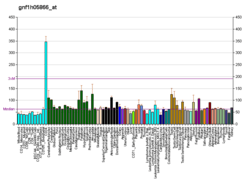GPSM1
G-protein-signaling modulator 1 is a protein that in humans is encoded by the GPSM1 gene.[5][6][7]
G proteins propagate intracellular signals initiated by G protein-coupled receptors. GPSM1, a receptor-independent activator of G protein signaling, is one of several factors that influence the basal activity of G protein signaling systems (Pizzinat et al., 2001).[supplied by OMIM][7]
References
- GRCh38: Ensembl release 89: ENSG00000160360 - Ensembl, May 2017
- GRCm38: Ensembl release 89: ENSMUSG00000026930 - Ensembl, May 2017
- "Human PubMed Reference:". National Center for Biotechnology Information, U.S. National Library of Medicine.
- "Mouse PubMed Reference:". National Center for Biotechnology Information, U.S. National Library of Medicine.
- Pizzinat N, Takesono A, Lanier SM (May 2001). "Identification of a truncated form of the G-protein regulator AGS3 in heart that lacks the tetratricopeptide repeat domains". J Biol Chem. 276 (20): 16601–10. doi:10.1074/jbc.M007573200. PMID 11278352.
- Peterson YK, Bernard ML, Ma H, Hazard S III, Graber SG, Lanier SM (Nov 2000). "Stabilization of the GDP-bound conformation of Gialpha by a peptide derived from the G-protein regulatory motif of AGS3". J Biol Chem. 275 (43): 33193–6. doi:10.1074/jbc.C000509200. PMID 10969064.
- "Entrez Gene: GPSM1 G-protein signalling modulator 1 (AGS3-like, C. elegans)".
Further reading
- Natochin M, Lester B, Peterson YK, et al. (2001). "AGS3 inhibits GDP dissociation from galpha subunits of the Gi family and rhodopsin-dependent activation of transducin". J. Biol. Chem. 275 (52): 40981–5. doi:10.1074/jbc.M006478200. PMID 11024022.
- Strausberg RL, Feingold EA, Grouse LH, et al. (2003). "Generation and initial analysis of more than 15,000 full-length human and mouse cDNA sequences". Proc. Natl. Acad. Sci. U.S.A. 99 (26): 16899–903. doi:10.1073/pnas.242603899. PMC 139241. PMID 12477932.
- Pattingre S, De Vries L, Bauvy C, et al. (2003). "The G-protein regulator AGS3 controls an early event during macroautophagy in human intestinal HT-29 cells". J. Biol. Chem. 278 (23): 20995–1002. doi:10.1074/jbc.M300917200. PMID 12642577.
- Kaushik R, Yu F, Chia W, et al. (2004). "Subcellular Localization of LGN During Mitosis: Evidence for Its Cortical Localization in Mitotic Cell Culture Systems and Its Requirement for Normal Cell Cycle Progression". Mol. Biol. Cell. 14 (8): 3144–55. doi:10.1091/mbc.E03-04-0212. PMC 181556. PMID 12925752.
- Adhikari A, Sprang SR (2004). "Thermodynamic characterization of the binding of activator of G protein signaling 3 (AGS3) and peptides derived from AGS3 with G alpha i1". J. Biol. Chem. 278 (51): 51825–32. doi:10.1074/jbc.M306300200. PMID 14530282.
- Gerhard DS, Wagner L, Feingold EA, et al. (2004). "The Status, Quality, and Expansion of the NIH Full-Length cDNA Project: The Mammalian Gene Collection (MGC)". Genome Res. 14 (10B): 2121–7. doi:10.1101/gr.2596504. PMC 528928. PMID 15489334.
- Du Q, Macara IG (2004). "Mammalian Pins is a conformational switch that links NuMA to heterotrimeric G proteins". Cell. 119 (4): 503–16. doi:10.1016/j.cell.2004.10.028. PMID 15537540.
- Rual JF, Venkatesan K, Hao T, et al. (2005). "Towards a proteome-scale map of the human protein-protein interaction network". Nature. 437 (7062): 1173–8. doi:10.1038/nature04209. PMID 16189514.
- Izaki T, Kamakura S, Kohjima M, Sumimoto H (2006). "Two forms of human Inscuteable-related protein that links Par3 to the Pins homologues LGN and AGS3". Biochem. Biophys. Res. Commun. 341 (4): 1001–6. doi:10.1016/j.bbrc.2006.01.050. PMID 16458856.
This article is issued from Wikipedia. The text is licensed under Creative Commons - Attribution - Sharealike. Additional terms may apply for the media files.




